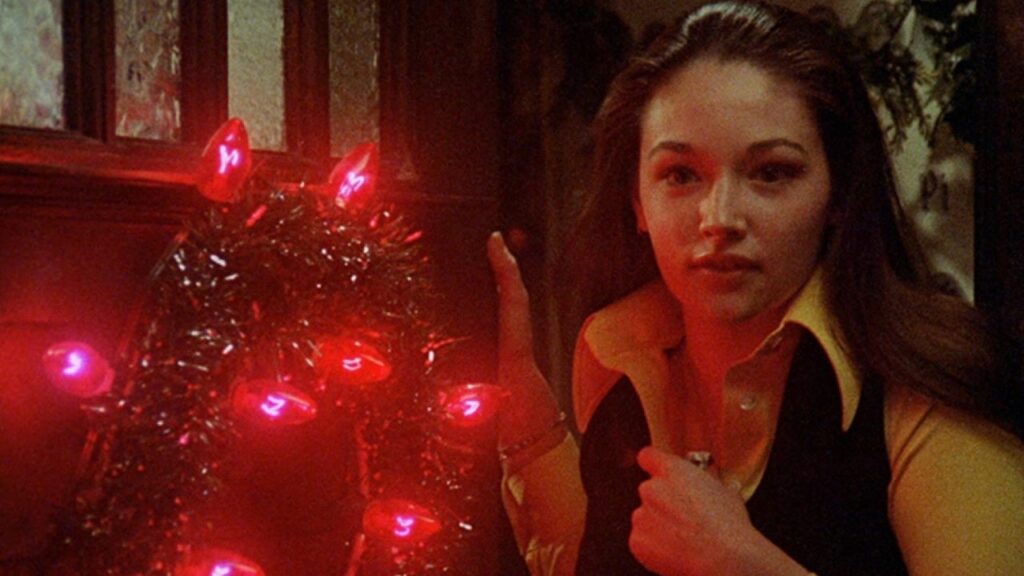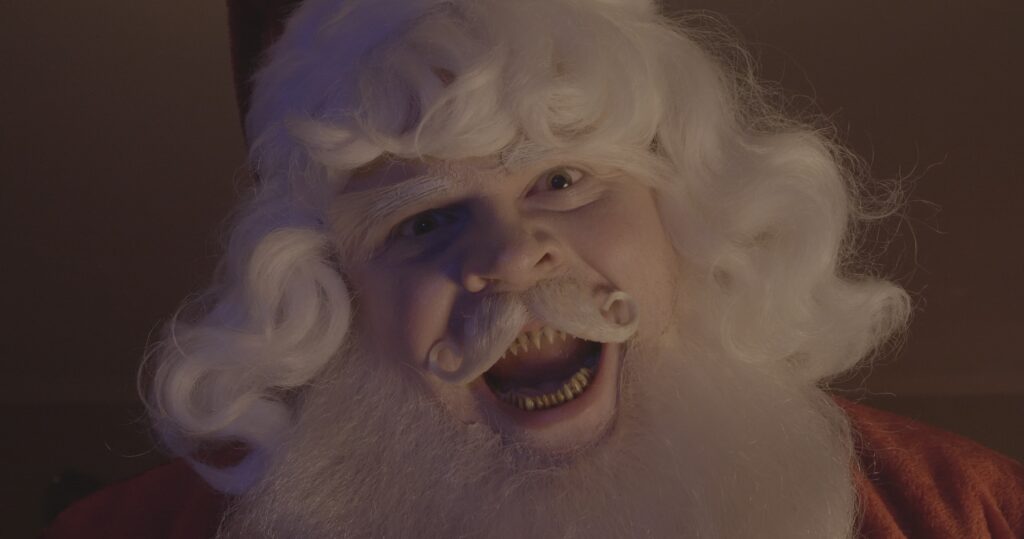|Andrew Neill|

Black Christmas plays in glorious 35mm at the Trylon Cinema from Friday, October 17 to Sunday, October 19. For tickets, showtimes, and other series information, visit trylon.org.
My first experience of cinematic horrors shattering the porcelain white purity of the holidays had to be The Nightmare Before Christmas. Six-year-old Andrew was not prepared for Santa to be kidnapped by demonic trick ‘r treaters and tortured by the Oogie Boogie Man, a sentient bag of squirming insects. Around the same time, little me also would have seen Home Alone, which led as a family holiday romp, but harbored within it the evil clanging boiler in Kevin McCallister’s basement and his leering, possibly murderous old neighbor! These early encounters introduced a young scaredy cat to holiday horror. However, it would be years later before I glimpsed true darkness lurking beyond the twinkly lights of Christmastime.
Director Bob Clark’s Black Christmas doesn’t have a skeletal song-and-dance man or booby-trapping boy prodigy. It’s a lean and vicious movie about a house full of sorority girls being serially harassed and murdered by a babbling lunatic who’s taken up residence in their attic. It’s one of the movies that set the template for the slasher genre, and the darker corners of Christmas it explores continue to inspire modern filmmakers, myself among them.
In 2019 I directed a holiday horror short called The Ho Ho Howling, which you can watch on YouTube. The movie is about a family facing off against an infernal incarnation of Santa Claus, whose magical gifts transform them for the worse. On the surface, The Ho Ho Howling has very little in common with Black Christmas aside from the holiday setting. But I’m going to take this opportunity to illustrate how the terrors of Bob Clark’s film echo through my own work. (Beware of spoilers from here on in.)
At their core, both Black Christmas and The Ho Ho Howling are home invasion stories. If you look at it from a canted angle, home invasion is baked into the mythology of Santa Claus. Children want this jolly old elf to squeeze his ass down their chimney, enter their home in the dead of night, and leave them presents. But what if this visitor had sinister intentions?
Billy, the holiday home intruder of Black Christmas, is a few steps removed from Santa Claus. He’s just some fuckin’ guy, but also a deranged psychopath. He enters the sorority house undetected during the film’s opening sequence and never leaves. Clark chooses to never show Billy onscreen in full. Often the camera takes on his point of view as he watches the sorority sisters from down a hallway or while hidden in a closet. It gives Billy a sort of omniscient presence and fills scenes in the house with dread. The women don’t know Billy is there until it’s too late, but the audience is painfully aware he could appear at any moment.
In The Ho Ho Howling, we literalized the idea of Santa as malevolent home invader. We show him in full view, depicting him as the iconic Claus before twisting it. We shot our actor Allen Voigt at low angles or foregrounded him in shots of the other characters to make him feel large and unpredictable. Allen plays Santa like a jungle cat playing with his food before going in for the kill. There’s a morbid curiosity in waiting for what he’s going to do to this family.
Crossing violence with Christmas feels transgressive. It shatters the image we have of stirring hot chocolate with a candy cane in front of a cozy fire and well-decorated tree. In the centerpiece sequence of Black Christmas, Clark deploys a cruel irony. He crosscuts between the character Jill (Olivia Hussey) listening to a group of carolers at the front door and Billy stabbing Barb (Margot Kidder) upstairs with a crystal unicorn sculpture. Clark cuts from close-ups of singing children to inserts of the bloody crystal horn. He foregrounds Barb’s other crystal sculptures during the stabbing to give the images a twinkly effect. The sequence grafts light and darkness together until the darkness warps the light into something haunting and unforgettable.
Mixing Santa and slashers specifically is well-trod territory. Movie psychos have been donning the red-and-white, suit-and-hat combo since Tales from the Crypt in 1972 and more famously in Silent Night, Deadly Night in 1984. Audiences seem to find a twisted glee in watching Santas go postal.

Our Santa in The Ho Ho Howling leans back toward the character’s magical origins, but with more biting. He’s a Were-Santa, who turns his victims into identical copies of himself with a single chomp. I still get a giddy rush when I see Allen brandish those razor-sharp teeth or rise up into frame with his white beard stained with blood. These images feel like a kind of blasphemy against the patron saint of consumerism. The guy who sells you Coca-Cola Classic at Christmastime shouldn’t be chowing down on cute suburban families, or wait… No, he definitely should.
This subversion of the traditional, wholesome image of Christmas is the appeal of holiday horror. If you’re among us sickos seeking this kind of thing, you may also be fed up with the imposing monolith of holiday cheer. As Andy Williams croons “It’s the Most Wonderful Time of the Year” on loop, each one of us faces the battle of how we’re supposed to be feeling versus how we’re actually feeling. The insidious joyfulness of the holidays instead brings on loneliness and isolation.
Black Christmas takes place at a sorority over the holidays. To borrow a title from a more recent film, the characters are holdovers. While most have left to spend the holiday break with their families, Jill, Barb, and Phyl (Andrea Martin) are staying behind. In the film’s opening sequence, Barb receives a call from her mother, who’s phoned to tell her not to come home. Mom is busy with a new boyfriend. One sister we meet, Clare (Lynne Griffin), is planning to go home with her father, but Billy gets to her first, suffocating her with a plastic garment bag. Given the triple whammy of family abandonment, the presence of a murderous lunatic, and the local police department’s general incompetence, the young women of Black Christmas are truly on their own.
The same can be said of the family in The Ho Ho Howling. After a couple establishing shots of a foreboding full moon and their lone, bedecked house, the world of the film feels entirely contained within four walls, unmoored from the outside world. As the Were-Santa picks off dad, mom, and daughter one by one, we never get the sense that any help is coming. When we finally break free from the prison of their home in the closing shots, we’re flying over a grid of other suburban houses as a chorus of howls echoes through the night. The same event we’ve just witnessed could be playing out under each and every roof below. We’re hovering above a neighborhood, but each home is its own island of horrors.
Thankfully, at least in my experience, the aftermath of making a holiday horror film is less isolating and violent than the events of the film itself. Something I did not expect when making a movie tied to Christmas is how every December it recirculates and expands its audience. The Ho Ho Howling now has almost half a million views on YouTube, and I continue to be dumbfounded when people post reaction videos and kill count breakdowns. People feeling inspired to create based on something my friends and I made is beautiful and unifying. It’s a continuum of creation. When you go back a ways, you’ll eventually run into Black Christmas, but you’ll find a host of other holiday horrors in between.
There’s an abiding hunger for Christmastime terrors. I know because I feel it. It’s why I made The Ho Ho Howling. December is inevitable, and when we’re in the thick of it, some of us want a break from Bing Crosby’s buttery tones and the anxiety of impending family visits. We want to see a little (but really a lot of) blood splattered across snow and tinsel. We want to watch Black Christmas because it’s a reminder and a relief that someone else has been through this Christmas thing, too, and they agree it can be hell.
Edited by Finn Odum
